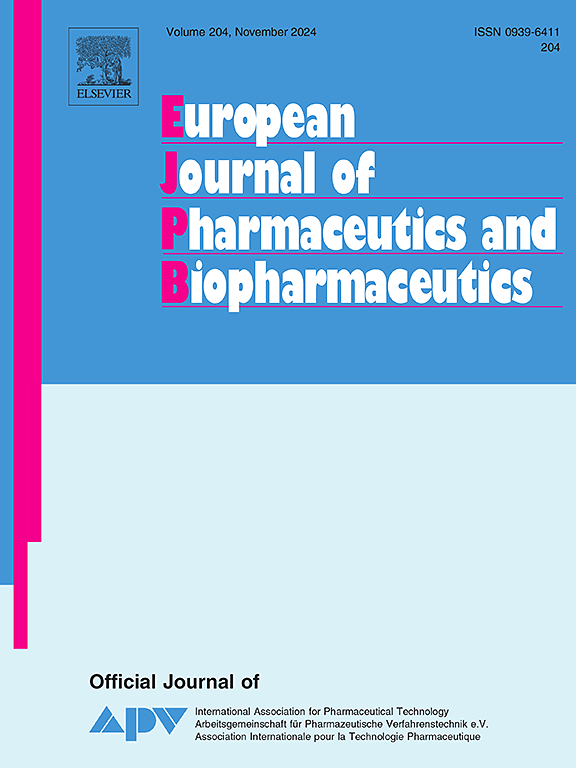Efficient nose-to-brain delivery of nine residues peptide (JAL-TA9) exhibiting hydrolytic activity against amyloid-β
IF 4.4
2区 医学
Q1 PHARMACOLOGY & PHARMACY
European Journal of Pharmaceutics and Biopharmaceutics
Pub Date : 2025-02-04
DOI:10.1016/j.ejpb.2025.114661
引用次数: 0
Abstract
JAL-TA9 (YKGSGFRMI), is a 9-residue catalytic peptide that cleaves amyloid β (Aβ) 42. Nasal administration was chosen to bypass the blood–brain barrier for efficient brain delivery of JAL-TA9 to treat Alzheimer’s disease (AD). Plasma clearance of JAL-TA9 after intravenous bolus injection in rats was very rapid, with a half-life of <1 min. The stability of JAL-TA9 in cerebrospinal fluid (CSF) was much better than that in plasma and whole blood in vitro, suggesting the advantage of direct nasal delivery to avoid rapid elimination from the blood. JAL-TA9 in CSF was 0.115 μg/mL 10 min after nasal administration to rats, but below the detection limit after intravenous injection, indicating a significant direct delivery of JAL-TA9 to the brain. In mice brain, JAL-TA9 concentration was higher after nasal administration than that after intraperitoneal administration. Additionally, peak concentration in the olfactory bulb (OB) after nasal application was at 5 min, whereas in the frontal and occipital brains peaked at 30 and 60 min, respectively, suggesting sequential backward translocation of JAL-TA9 within the brain after direct transport from the nasal cavity to the OB. Therefore, nasal administration allows the efficient delivery of JAL-TA9 to the brain and may be a potential in AD treatment.

具有抗淀粉样蛋白-β水解活性的九残基肽(JAL-TA9)的高效鼻到脑递送。
JAL-TA9 (YKGSGFRMI)是一种具有9个残基的催化肽,可裂解β淀粉样蛋白(a β) 42。选择鼻腔给药绕过血脑屏障,有效地给药JAL-TA9以治疗阿尔茨海默病(AD)。大鼠静脉注射JAL-TA9后血浆清除率非常快,半衰期为
本文章由计算机程序翻译,如有差异,请以英文原文为准。
求助全文
约1分钟内获得全文
求助全文
来源期刊
CiteScore
8.80
自引率
4.10%
发文量
211
审稿时长
36 days
期刊介绍:
The European Journal of Pharmaceutics and Biopharmaceutics provides a medium for the publication of novel, innovative and hypothesis-driven research from the areas of Pharmaceutics and Biopharmaceutics.
Topics covered include for example:
Design and development of drug delivery systems for pharmaceuticals and biopharmaceuticals (small molecules, proteins, nucleic acids)
Aspects of manufacturing process design
Biomedical aspects of drug product design
Strategies and formulations for controlled drug transport across biological barriers
Physicochemical aspects of drug product development
Novel excipients for drug product design
Drug delivery and controlled release systems for systemic and local applications
Nanomaterials for therapeutic and diagnostic purposes
Advanced therapy medicinal products
Medical devices supporting a distinct pharmacological effect.

 求助内容:
求助内容: 应助结果提醒方式:
应助结果提醒方式:


